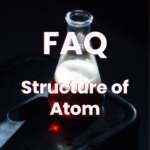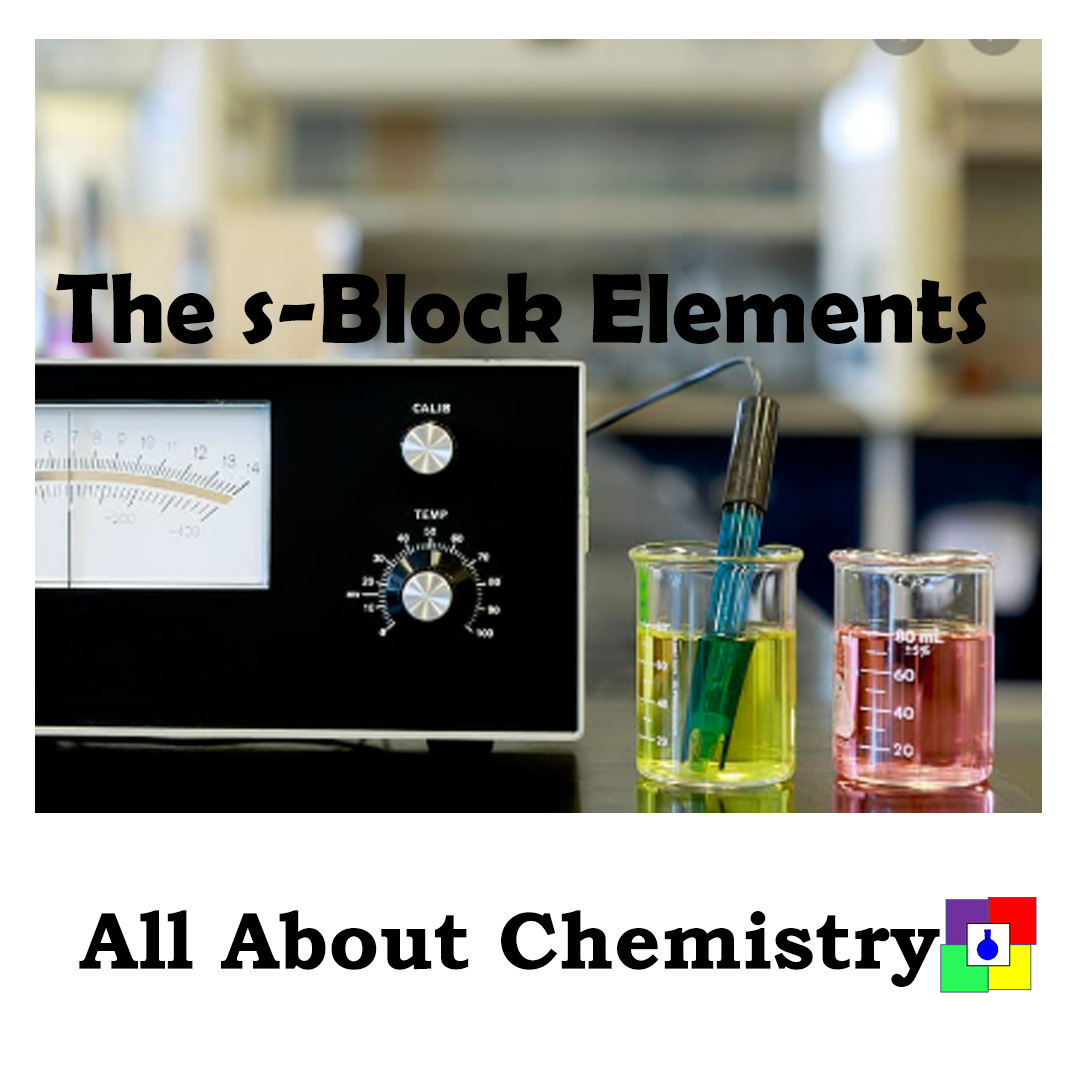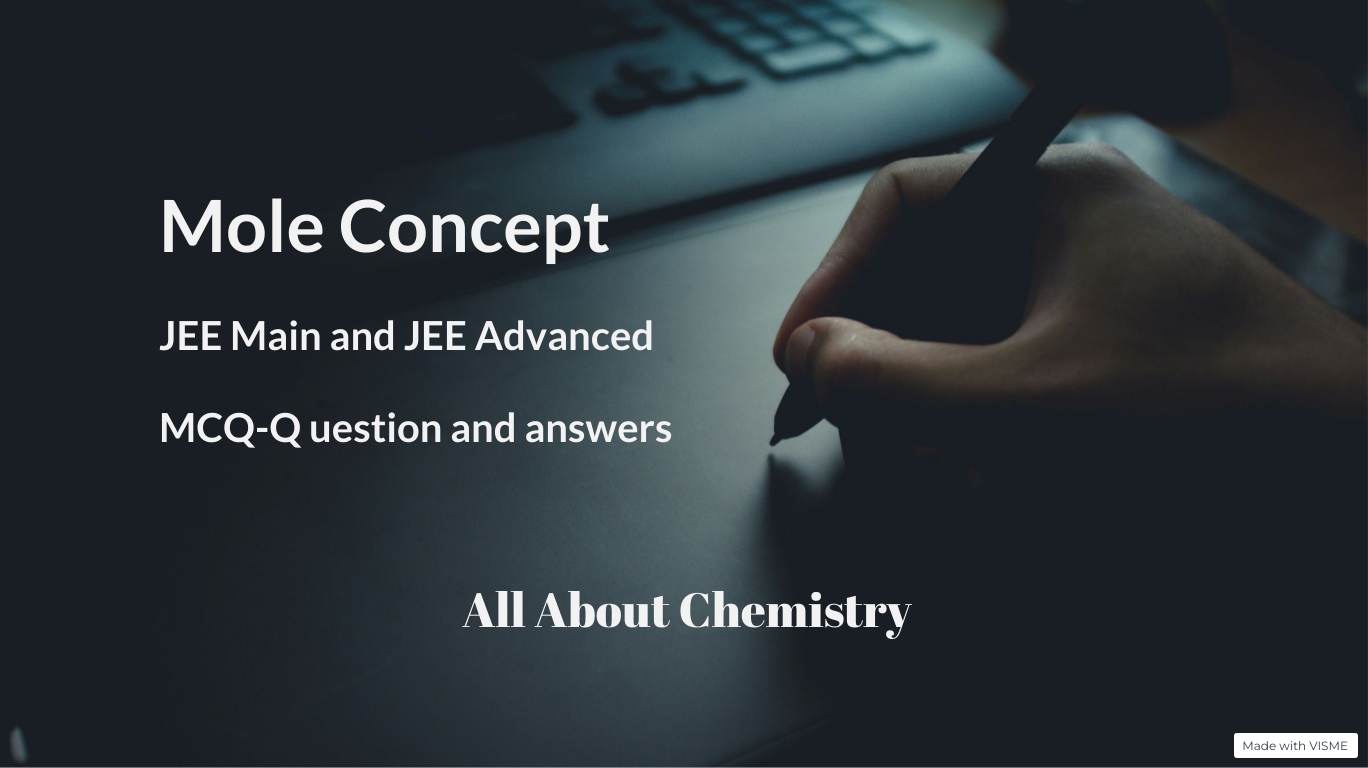GROUP 1 ELEMENT: ALKALI METALS
In this post, we will come across detail study of the physical and chemical properties of s-block elements. We will also study the preparations, physical and chemical properties; and uses of the different compounds of s-block elements.
Introduction:
The long form of the periodic table is divided into four groups- s, p, d and f blocks.Elements in which the differentiating (last) electron enters into the s sub shell are called s-block elements.
Group 1 includes Lithium (Li), Sodium(Na),Potassium(K),Rubidium(Rb). Caesium(Cs) and Francium(Fr).These elements are called alkali metals as the oxides and hydroxides of these elements are strongly alkaline in nature.The word ‘alkali’ is derived from the Arabic word al-quis which meaning plant ashes. Francium is radioactive in nature.
The electronic configuration these elements are:
| Element | Atomic Number | Electronic configuration |
| Li | 3 | 1s22s1 |
| Na | 11 | 1s22s22p63s1 |
| K | 19 | 1s22s22p63s23p64s1 |
| Rb | 37 | 1s22s22p63s23p63d104s24p65s1 |
| Cs | 55 | 1s22s22p63s23p63d104s24p64d105s25p66s1 |
| Fr | 87 | 1s22s22p63s23p63d104s24p64d104f145s25p65d106s26p67s1 |
Predicting the position of a s-block element:
From the electronic configuration of an element, its position in the long form of the periodic table can be predicted. If the valence shell electronic configuration of an element is xs1 or xs2 then its
Period is x and its group is 1 or 2 respectively. As, the valence shell electronic configuration of Potassium is [Ar]4s1. It indicates, potassium lies in Period 4 and group 1.
Occurrence:

Rubidium occurs in the minerals leucite, carnallite,pollucite and zinnwaldite.
Physical properties:
Some important physical properties of the elements of group 1 are given below:
| Property | Li | Na | K | Rb | Cs |
| Atomic Number | 3 | 11 | 19 | 37 | 55 |
| Atomic Mass | 6.94 | 22.99 | 39.1 | 85.48 | 132.91 |
| Atomic radius(pm) | 134 | 154 | 197 | 211 | 225 |
| Ionic radius(pm) | 60 | 95 | 133 | 148 | 169 |
| Ionisation potential(IP1)(kJ/mol) | 520.1 | 497.2 | 418.7 | 403 | 375.7 |
| Electronegativity | 1.0 | 0.9 | 0.8 | 0.8 | 0.7 |
| Density g/cc | 0.534 | 0.972 | 0.859 | 1.53 | 1.90 |
| Melting point(0C) | 180 | 97.8 | 64.0 | 39.0 | 28.5 |
| Boiling point(0C) | 1326 | 883 | 756 | 688 | 690 |
| E0ox(V) | 3.04 | 2.71 | 2.92 | 2.99 | 2.99 |
Physical state:
Elements of s-block are basically silvery-white (due to presence of mobile electrons), soft (due to weak metallic bond), and light metals. These elements are highly reactive, thus are kept under kerosene oil. They can be easily cut with a knife.
Atomic size or atomic radii:
The size of the alkali metals increases down a group as new shells are added. Hence Li<Na<K<Rb<Cs
Ionic Radii:
Alkali metals can form M+ ion. The ionic radii of these elements increase down the group. The size of the ions is less than the atomic size of the respective element due to- i) removal of the outermost shell ii) increase in the effective nuclear charge. Hence Li+<Na+<K+<Rb+<Cs+

Atomic volume:
Down the group the atomic volume increases. Hence Li<Na<K<Rb<Cs
Density:
Density of the alkali metals increases down the group. The exceptional behaviour of potassium is due to unusual increase in atomic size. Hence Li<K<Na<Rb<Cs.

Melting and boiling point:
The melting and boiling point of the alkali metals gradually decrease down the group. The values of the melting and boiling point are apparently low because the binding energy (Binding energy is the amount of energy required to decompose a molecule, atom, or nucleus into its constituent particles) of the atoms in the crystalline lattice is low. The binding energy is low due to –Presence of the single valence electron, Large size of the atom

Ionisation potential and metallic nature:
The ionisation potential decreases down the group because down a group the no of shell increases, the screening effect also increases, the nuclear pull on the valence shell electrons decreases, the I.P decreases.

The first I.P of the alkali metals are the lowest compared to the elements of other group as-
- Due to the large size of the atoms, the nuclear pull on the valence electron is less and hence the electron can be easily removed.
- After eliminating an electron it attains stable noble gas configuration.
As the I.P decreases down the group the metallic nature increases
This property of emitting electron easily is utilized in photoelectric effect. (The phenomenon of emitting electrons from the metal surface when light strikes on its surface) K and Cs are used in the photoelectric cells.
Oxidation state:
The alkali metals due to the low I.P,easily lose the outermost valence electron and for uni-positive ion showing +1 oxidation state.
M+ possess noble gas electronic configuration hence apparently large amount of energy is required to remove the next electron hence the second I.P of these elements are fairly large.
Magnetic property and color of ions:
M+ possess noble gas electronic configuration hence it is diamagnetic (due to absence of unpaired electron)
So also, due the absence of the unpaired electrons compounds of M+ is colourless.
Conductivity:
Alkali metals are good conductors of heat and electricity due to the presence of loosely bounded valence electron.
Flame colouration:
The salts of the alkali metals (especially chloride) impart characteristic colour to the Bunsen flame.
| Li | Na | K | Rb | Cs |
| Crimson red | Golden Yellow | Pale violet | Violet | Violet |
Salts of alkali metals are volatile in nature, when heated in Bunsen flame, the outermost valence electron jumps to the higher state by absorbing energy. When the excited electrons return to the ground state, they release the absorbed energy as visible light.
Lattice energy:
Strong electrostatic force of attraction exist between the ions hence the lattice energy of the salts of alkali metals are quite high. Down the group the lattice energy decreases with the increase in size. Hence, Li>Na>K>Rb>Cs
Hydration of ions:
M+ undergoes hydration with water molecule hence is water soluble.The degree of hydration of M+ in water decreases down the group (as the size increases). But the ionic conductance of these hydrated ions increases down the group.
Hydration energy:
It is the energy released in the hydration of the ions. It decreases down the group.
Chemical properties:
Reducing properties:
As the ionisation potential decreases down the group, the reducing character as well as the reactivity increases downs the group (Gaseous state). Hence Li<Na<K<Rb<Cs.
But in aqueous solution, the order is Na<K<Rb<Cs<Li. High reducing nature of lithium is due to large heat of hydration (due to its small size)
Action of water:
Alkali metals react vigorously with water forming hydroxides and hydrogen.
2M+2H2O→2MOH + H2
The reactivity with water increases down the group.
Action of moist air:
Alkali metals form oxide with oxygen, which tarnish the metal. Thus the metals are stored in kerosene or paraffin oil. Li being light is kept wrapped in paraffin wax. The reactivity with oxygen increases down the group.
Action of hydrogen:
Alkali metals form ionic hydride with hydrogen. The reactivity decreases down the group. These hydrides are high melting ionic solids and behave as strong reducing agents. The reducing nature of the hydrides increases down the group.
Hence LiH<NaH<KH<RbH<CsH
Action of halogens:
Alkali metals form halides with halogen reacting violently.
2M + X2→2MX
Towards a particular halogen, the reactivity increases down the group. Towards a particular alkali metal the reactivity of the halogens follows F>Cl>Br>I order.
Action with sulphur and phosphorous:
Alkali metals form sulphides and phosphides with sulphur and phosphorous respectively.
Solubility in liquid ammonia:
Alkali metals are soluble in liquid ammonia forming a blue metal-ammonia solution.
- M→M+ + e–
- M+ + xNH3→[M(NH3)x]+
- e– + y NH3→[e(NH3)y]–
Overall Reaction: M+ (x+y) NH3→[M(NH3)x]+ + [e(NH3)y]–
Some properties of metal-ammonia solution are:
- With the increase in the concentration the colour of the solution changes to bronze with metal lustre due to formation of metal ion cluster.
- The blue colour solution is paramagnetic while the bronze solution is diamagnetic due to the presence of unpaired electrons and formation of electron cluster with opposite spin respectively.
- Due to the presence of ammoniated cation and anion the blue solution has high conductivity.
- The blue solution act as a powerful reducing agent.(Birch reduction)
- The solution is quite stable but in presence of catalyst like Iron oxide , platinum black the solution decomposes to produce metal amide and hydrogen.M + NH3→MNH2 + H2
General characteristics of the compounds of the alkali metals:
Oxide:
Li forms monoxide, Na forms peroxide while K, Rb and Cs forms superoxide.Down the group, the tendency to stabilise the large anions by the large cations through lattice energy increases, thus the tendency to form superoxidesincreases.Peroxides and superoxides are powerful oxidising agents.
- 4Li +O2 → 2Li2O
- 2Na + O2 → Na2O2
- K + O2→ K2O
Hydroxide:
Hydroxides are prepared by reacting metals directly with water or dissolving the oxide in water. The hydroxides of the alkali metals are strong base as, due to the low ionization potential of the metals the M-O bond in M-O-H get easily rapture forming M+ and OH- ion. Down the group, the ionization potential of the alkali metals decreases hence the rapture of M-O bond becomes easier. Thus, the basic characteristics of the hydroxides increase. LiOH<NaOH<KOH<RbOH<CsOH
These hydroxides are thermally stable, they melts without decomposing.
Hydrides:
The hydrides of the alkali metals are high melting ionic solids and behave asstrong reducing agents. The reducing nature of the hydrides increases down the group as the ionisation potential of the alkali metal increases. LiH<NaH<KH<RbH<CsH
2Na + H2→2NaH
Carbonates and bicarbonates:
- Except for Lithium carbonate, all other carbonates are highly stable to heat.
- Due to the strong polarising action of small Li+ the electron cloud of the oxygen atom of the carbonate radical get distorted, making the C-O bond weak. As a result when heated Li2CO3 breaks to produce oxide and carbon dioxide.
- The stability of the carbonates increases down the group due to the increase in the electropositive nature of the metal.Li2CO3< Na2CO3< K2CO3< Rb2CO3< Cs2CO3
- The carbonates are water-soluble and the solubility increases down the group.
- The aqueous solution of carbonates is alkaline in nature because on hydrolysis, carbonates produce a strong base and a weak acid.Na2CO3 + 2H2O → 2NaOH + H2CO3
- Bicarbonates of the alkali metals are soluble in water and quite stable to heat. On heating, bicarbonates decompose to carbonates and carbon dioxide. 2NaHCO3 → Na2CO3 + CO2 + H2O
Nitrates:
- Nitrates of the alkali metals are formed by reacting carbonates or bicarbonates or hydroxides with nitric acid.Na2CO3 + 2HNO3 → 2NaNO3 + CO2 + H2O
- On heating nitrates, nitrites are formed except LiNO3.2NaNO3→ 2NaNO2 + O2
- LiNO3 when heated produce nitric oxide. 4LiNO3 → 2Li2O + 4NO2 + O2
- All the nitrates are soluble in water. The stability of the nitrates increases with the
- increase in the electropositive nature of the nitrates. LiNO3<NaNO3<KNO3<RbNO3<CsNO3
Sulphates:
All sulfates of alkali metals are water-soluble except lithium sulfate and form double salts with trivalent metals like Al, Fe, and Cr. These double salts are called alum (M2SO4. M2’(SO4)3. 24H2O, where M= Na+, K+, NH4+ and M’ = Al3+, Fe3+, Cr3+)
The five important alums are-potash alum(K2SO4. Al2(SO4)3. 24H2O),sodium alum(Na2SO4. Al2(SO4)3. 24H2O), ammonium alum[ (NH4)2SO4. Al2(SO4)3. 24H2O],ferric alum [(NH4)2SO4. Fe2(SO4)3. 24H2O],chrome alum (K2SO4. Cr2(SO4)3. 24H2O)
Sulphates when fused with charcoal, sulphides are formed.
M2SO4 + 4C → M2S + 4CO
Halides:
The halides of the alkali metals are prepared by the direct combination of the metal with halogen. It can also be prepared by reacting aqueous halogen acid with carbonates and hydroxides of the alkali metals.
- 2M + X2→ 2MX
- MOH + HX → MX + H2O
- M2CO3 + 2HX → 2MX + CO2 + H2O
Towards a particular halogen, the reactivity increases down the group-13 elements. Towards a particular alkali metal the reactivity of the halogens follows F>Cl>Br>I order.With the decrease in the size of the cation, its polarising power increases and hence the covalent character increases in the following order: LiCl>NaCl>KCl>RbCl>CsCl.
The solubility in water follows the order: NaCl<KCl<LiCl<RbCl<CsCl because, with the increase in the size of the cation, the hydration energy becomes more than the lattice energy. The unusual solubility of LiCl may be due to the small size of Li+ ion and higher hydration energy.
The melting point follows the order: NaCl<KCl<RbCl<CsCl<LiCl as the lattice energy decreases with the increase in the size of the alkali metal.
The unusual variation of the LiCl may be due to its covalent nature.
Abnormal Behavior of Lithium:
Lithium is the first element of the alkali metals. It shows anomalous behaviour in many of the cases like:

- Li is harder while other alkali metals are soft.
- High melting and boiling point
- Li forms monoxide while others form peroxides and superoxides
- Only Li can form nitrides with nitrogen.
- Hydroxides of the alkali metals are strong base while that of Li is a weak base.
- LiH is more stable than the other hydrides.
- Except LiOH and Li2CO3, the rest does not decompose on heating.
- Alkali metals on heating forms nitrites except LiNO3 which produces Li2O, NO2 and Oxygen.
- The carbonates, oxides, hydroxides, oxalates, fluorides and phosphates of Li are sparingly soluble in water, while for the other alkali metals , they are water soluble.
- LiClshows unusual solubility and melting point.
- All sulphates of alkali metals are water soluble and form double salts with trivalent metals like Al,Fe and Cr except lithium sulphate.
The anomalous behavior is due the following reasons:
- Small size of Li atom and Li+ ion.
- High covalent nature due to high polarising property.
- High ionisation potential and low electropositive nature.
- Absence of d orbital
- Can form strong intermetallic bonding
Diagonal relationship of Li and Mg:
Li resembles Mg due to almost similar atomic and ionic size. (Li=152pm, Mg=160pm, Li+=76pm, Mg2+=72pm) Their similarities are:
- Similar electronegativity
- Hard and lighter
- Forms weak bases
- Forms ionic nitrides
- Hydroxides and carbonates decomposes on heating
- Can form monoxides mainly
- Chlorides are covalent in nature
Chlorides and perchlorates are ethanol soluble
Preparation , properties and uses of some important compounds:
Sodium chloride (NaCl)
Preparation:
From sea water:

In tropical countries, sodium chloride can be prepared by evaporating sea water. Sea water taken in a large shallow iron tank is evaporated by wind and sun. As the sea water evaporates, the solution gets concentrated and crystal of sodium chloride separates out. The crystals are separated leaving behind the mother liquor called bittern. This mother liquor contains magnesium chloride. The common salts produced by this process possess sulphates and chlorides of magnesium and calcium as impurities.
From sodium hydroxide:
In laboratory sodium chloride is prepared by reacting sodium hydroxide with hydrochloric acid.
NaOH + HCl → NaCl + H2O
Sodium chloride thus produced is separated out as crystals by evaporation
From metallic sodium:
Pure sodium chloride is prepared by passing pure and dry chlorine gas over heated sodium.
2Na + Cl2→ 2NaCl
Purification of sodium chloride: Common salt obtained from sea water contains sulphates and chlorides of Ca and Mg as impurities. Thus, a steam of pure hydrogen chloride gas is passed through a saturated solution of common salt, pure sodium chloride separates out due to common ion effect (Cl–) leaving behind the impurities in the solution. The crystals are collected, washed with pure conc. HCl and then heated in a platinum container to remove hydrogen chloride and water. By this process nearly 100% pure sodium chloride is obtained.
Properties:
- Sodium chloride is a colorless crystalline (fcc) solid. It is soluble in water forming [Na(H2O)8]+ion. The solubility of sodium chloride in water hardly changes with temperature.
- Common salt contains MgCl2 and CaCl2 as impurities which are deliquescent substances. That’s why common salt becomes wet in the rainy season. In order to prevent it Ca3PO4 or Ca(H2PO4)2 is added.
- Its density is 2.165 g/cm3. Its melting and boiling point are 8010C and 14130C respectively.
- Sodium chloride is a strong electrolyte. It ionizes completely to form Na+ and Cl–ions.NaCl→Na+ + Cl-
- Sodium chloride when heated with conc. sulphuric acid at a temperature below 2000C sodium bisulfate and hydrogen chloride is formed.NaCl + H2SO4 → NaHSO4 + HCl. At a temperature above 2000C sodium sulfate and hydrogen chloride are formed. 2NaCl + H2SO4 → Na2SO4 + 2HCl
- When a mixture of sodium chloride and MnO2 is heated with conc.sulphuric acid, greenish-yellow chlorine gas is evolved.2NaCl + MnO2 + 3H2SO4 → 2NaHSO4 + MnSO4 + Cl2↑ + 2H2O
- When sodium chloride solution is added to silver nitrate solution white precipitation is obtained. The precipitation gets dissolved in ammonium hydroxide solution but reappears on adding nitric acid solution.NaCl + AgNO3 → AgCl ↓ + NaNO3
Uses:
- It is used as table salt.
- It is used to manufacture sodium carbonate, sodium hydroxide, and sodium peroxide.
- It is used to make the freezing mixture and preserving food.
Sodium hydroxide (NaOH)
Preparation:
Causticising process:

In this process, 20% sodium carbonate solution is heated with excess quick lime at 80-900C. Calcium carbonate being insoluble precipitates out leaving behind sodium hydroxide in the solution. This reversible reaction is favored by increasing the concentration of quick lime and decreasing the concentration of CO32- ion. Thus an optimum concentration of 20% sodium carbonate is used.
CaO + H2O → Ca(OH)2
Na2CO3 + Ca(OH)2 →2NaOH + CaCO3↓
By this process, a strong alkali (NaOH) is produced from a weak one(Na2CO3). Thus it is called causticising process.
Electrolytic process:
In the recent time sodium hydroxide is prepared by electrolysis of saturated sodium chloride solution.
When electric current is passed through an aqueous solution of sodium chloride, it ionises to form Na+, H+ OH– and Cl–ions .
NaCl→Na+ + Cl–
H2O→H+ + OH–
At cathode: H+ ion is preferentially discharged at the cathode.
H+ + e → H,H + H → H2↑
At anode: Cl– ion is discharged due to high concentration of Cl– ion.
Cl– -e → Cl,Cl + Cl → Cl2 ↑
The spectator ions which remain in the solution combine to form sodium hydroxide.
Na+ + OH– →NaOH
The main disadvantages of this process are-
- Hydrogen and chlorine produced at the electrodes may cause explosion.
- Sodium hydroxide produced may react with chlorine to form sodium chloride, sodium hypochlorite and sodium chlorate. Hence some part of sodium hydroxide is lost.
Cl2 + 2NaOH → NaCl + NaOCl + H2O
3Cl2 + 6NaOH → NaCl + NaClO3 + 3H2O
To overcome these disadvantages, three types of cells are frequently used-
- Nelson cell
- Castner-Kellner cell
- Kellner- Solvey cell
- Nelson cell or Diaphragm cell:
It consists of a U-shaped vessel with perforated steel covered with layer of asbestos. The U-shaped steel vessel serves as cathode and the porous asbestos acts as a diaphragm which separates cathode from anode. Saturated solution of sodium chloride is introduced into the U-shaped vessel. A graphite rod is partly immersed in the sodium chloride solution which acts as anode. Steam is blown into the cathode through an inlet tube.
- Castner-Kellner cell:
It consists of a large rectangular tank with three compartments separated by slate partition. Mercury is made to flow at the bottom which acts as an intermediate electrode. The outer compartments contain brine solution and fitted with graphite anodes whereas the central compartment contains very dilute NaOH solution and fitted with iron cathode.
Outer compartment:
NaCl → Na+ + Cl–
H2O→ H+ + OH–
- At anode:Cl– -e → Cl,Cl + Cl → Cl2↑
- At cathode:Na+ + e → Na
Sodium produced at the cathode dissolves in mercury forming sodium amalgam and passes into the central compartments.
Central compartment:
NaOH→ Na+ + OH–
H2O→ H+ + OH–
- At cathode: H++e→H, H+H→H2↑
- At anode:OH– →OH + e, Na2Hgx + 2OH → 2NaOH + xHg
- Kellner- Solvey cell
It consists of two chambers. The upper one is called primary cell and the lower one is called secondary cell or decomposer. The primary cell consists of a slate made rectangular cell. A thin layer of Hg flows along its slightly sloping floor which mainly serves as a cathode. Graphite and copper rods are dipped in the brine solution kept in it. These rods act as anode.
- At anode:Cl– -e →Cl, Cl+Cl → Cl2↑
- At cathode:Na++e →Na, 2Na + xHg→ Na2Hgx
Sodium amalgam thus produced in the primary cell flows into the lower chamber made of iron which contains water. Here sodium amalgam acts as anode and iron acts as the cathode.
H2O→ H+ + OH–
- At anode: Na2Hgx → 2Na+ + xHg + 2e
- At cathode:H+ + e → H,H + H → H2↑
Properties:
- It is a white deliquescent crystalline solid.
- It is highly soluble in water forming a strong alkaline solution and liberate a large amount of heat. Its aqueous solution is slippery to touch.
- It melts at 3180C. Its density is 2.3g/cc.
- NaOH produces a white ppt. with Zn, Sn, and Al which is soluble in excess NaOHdue to the formation of zincate, stannate, and aluminate respectively.
- ZnCl2+2NaOH→Zn(OH)2+2NaCl
- Zn(OH)2+2NaOH→Na2ZnO2+2H2O
- SnCl2+2NaOH→Sn(OH)2+2NaCl
- Sn(OH)2+2NaOH→Na2SnO2+2H2O
- AlCl3 + 3NaOH→Al(OH)3 + 3NaCl
- Al(OH)3 + NaOH → NaAlO2 + 2H2O
- NaOH reacts with silver nitrate and mercuric chloride to produce silver hydroxide and mercuric hydroxide respectively. Silver hydroxide and mercuric hydroxide decomposes to form respective oxides.
- 2AgNO3 + 2NaOH→2AgOH + 2 NaNO3
- 2AgOH → Ag2O (brown)↓ + H2O
- HgCl2 + 2NaOH → Hg(OH)2 + 2NaCl
- Hg(OH)2 → HgO (yellow)↓ + H2O
- Sodium hydroxide reacts with phosphorous, halogens, boron silicon, silica, ammonium salt, and carbon monoxide to produce hypophosphite, hypohalite, halite, borate, thiosulphate, silicate, and sodium formate.
- P4 + 3NaOH + 3H2O→ PH3↑ + 3NaH2PO2
- X2 + 2NaOH(cold and dil.) → NaX + NaOX + H2O
- 3X2 + 6NaOH(hot and conc.) → NaX + NaXO3 + 3H2O
- 2B + 6NaOH→ 2Na3BO3 + 3H2
- 12S + 6NaOH→ Na2S2O3 + 2Na2S5 + 3H2O
- Si + 2NaOH + H2O → Na2SiO3 + 2H2
- SiO2 + 2NaOH→ Na2SiO3 + H2O
- NH4Cl + NaOH→NaCl + NH3 + H2O
- CO + NaOH→HCOONa
- It reacts with carbon dioxide, sulfur dioxide and phosphorous pentoxide forming sodium carbonate, sodium sulfite and phosphate respectively.
- 2NaOH+CO2→Na2CO3+H2O
- 2NaOH+SO2→Na2SO3+H2O
- P2O5 + 6NaOH →2Na3PO4 + 3H2O
- NaOH produces dirty green, reddish-brown, green and blue with Fe2+,Fe3+,Cr3+ and Cu2+ ions.
- FeCl2+2NaOH→Fe(OH)2+2NaCl
- FeCl3+3NaOH→Fe(OH)3+3NaCl
- CrCl3+3NaOH→Cr(OH)3+3NaCl
- CuSO2+2NaOH→Cu(OH)2+Na2SO4
Uses:
- It is used in the manufacture of dyes, soap, paper, artificial silk etc.
- It is used in petroleum refining, purification of bauxite, preparing of pure fats and oils, textile industries, etc.
- It is used as a laboratory reagent.
Sodium carbonate (Na2CO3)
Preparation by Solvay process:

- Ammonia is passed through a brine solution ( sodium chloride). Then excess CO2 is passed through this solution keeping the temperature at 30-350C. Carbon dioxide react with aqueous ammonia to produce ammonium bicarbonate.
- NH3 + H2O + CO2 → NH4HCO3
- Ammonium bicarbonate reacts with sodium chloride to produce ammonium chloride and sodium bicarbonate. At 350C, sodium bicarbonate separates out.
- NH4HCO3 +NaCl → NH4Cl + NaHCO3↓
- Sodium bicarbonate is calcined to produce sodium carbonate and carbon dioxide.
- 2NaHCO3 → Na2CO3 + H2O + CO2↑
- Carbon dioxide produced in this process is again used for the carbonation of ammoniacal brine.
- Ammonium chloride obtained is boiled with lime to regenerate ammonia.
- 2NH4Cl + Ca(OH)2 → 2NH3↑ + 2H2O + CaCl2
- Lime and carbon dioxide are produced by heating limestone in a kiln.
- CaCO3 → CaO + CO2↑
Advantages of the process:
- The raw materials common salt and lime stone are cheap and easily available. Hence the process is not expensive.
- The process is continuous , less fuel consuming and produces a high amount of sodium carbonate.
- Almost 99.5% pure sodium carbonate is produced. Ammonia and carbon dioxide regenerated can be used again and again.
Disadvantages of the process:
- CaCl2 obtained has no adequate use.
- About 1/3 rd of NaCl initially taken remains unchanged and get wasted.
- Some part of ammonia is lost in this process.
- Potasium carbonate cannot be prepared by this process as potassium bicarbonate produced as an intermediate is highly soluble in water and thus does not precipitate out.
Properties:
- It is a white crystalline solid.
- Decahydrated sodium carbonate (Na2CO3.10H2O) is known as washing soda.It is highly water soluble.
- When washing soda is heated below 1000C produce Na2CO3.H2O and when heated above it, Na2CO3 is produced. Anhydrous Na2CO3 is called soda ash.
- Sodium carbonate reacts with HCl to liberate CO2(effervescence)
- Na2CO3 +2HCl→2NaCl+H2O+CO2
- White ppt. of calcium carbonate is formed when sodium carbonate is reacted with milk of lime.
- Ca(OH)2+ Na2CO3→CaCO3 +2NaOH
Uses:
- It is used for softening water.
- It is used in the manufacture of borax, soap, paper, NaOHetc.
- It is used in petroleum refining, textile industries, etc.
- It is used as a laboratory reagent.
- It is also used in paints, dyes, and in fusion mixture.
Sodium bicarbonate(NaHCO3)
Preparation:

Sodium bicarbonate is produced when carbon dioxide is passed through a saturated sodium carbonate solution.Na2CO3+H2O+CO2→2NaHCO3
Properties:
- It is a white crystalline substance, sparingly soluble in water.
- When heated it produces sodium carbonate.
- 2NaHCO3→ Na2CO3+H2O+CO2
- When reacted with a mineral acid, it produces effervescence.
- NaHCO3 +HCl→NaCl+H2O+CO2
- Sodium sesquicarbonate (Na2CO3. NaHCO3.2H2O) is produced when the equimolecular amount of sodium carbonate and bicarbonate is subjected to crystallization.
- The aqueous solution of NaHCO3 is alkaline in nature.
- NaHCO3 + H2O → NaOH + H2CO3
Uses:
- It is used in the preparation of baking powder(a mixture of sodium bicarbonate, potassium hydrogentartarate, and alum).
- It is used as an antacid and mild antiseptic.
- It is used in fire extinguishers.
- It is used in aerated drinks.
Sodium thiosulphate(Na2S2O3.5H2O)
It is a salt of thiosulphuric acid, H2S2O3, an unstable acid.Pentahydrate sodium thiosulphate (Na2S2O3.5H2O)is also called Hypo.

Preparation
Spring’s reaction:
It is prepared by reacting to a calculated amount of iodine with a mixture solution of sodium sulfide and sodium sulfite. Then the final solution is subjected to crystallization. When crystals of sodium thiosulphate separate out.
Na2S+Na2SO3+I2→2NaI+Na2S2O3
This reaction is known as Spring’s reaction.
From sodium sulphite:
Sodium sulphite is prepared by passing sulphur dioxide through saturated sodium carbonate solution. Sodium sulphite produced is boiled with sulphur. The reaction mixture is stirred and heated till the alkaline nature of the solution disappears. The final solution is filtered. Excess sulphur is separated by filtration. The filtrate is concentrated to crystalline out sodium thiosulphate crystals.
Na2CO3 + SO2 → Na2SO3 + CO2
Na2SO3 + S → Na2S2O3
From sodium sulphide:
The waste liquor obtained during the production of sodium sulphide contains sodium carbonate and sodium sulphite in it. This waste liquor is concentrated by evaporation and through it sulphur dioxide gas is passed. The solution produced is subjected to crystallisation when sodium thiosulphate separates out.
2Na2S +Na2CO3 + 4SO2 → 3Na2S2O3 + CO2
2Na2S +Na2SO3 + 3SO2 → 3Na2S2O3
Properties:
- It is a white, odourless, monoclinic crystal with a melting and boiling point of 48.30C and 1000C respectively.
- When heated to 2170C it loses its all water of crystallisation and form anhydrous.
- Na2S2O3. 5H2O → Na2S2O3 + 5H2O
- Above 2200C it decomposes to sodium sulphate and pentasulphide.
- 4Na2S2O3 → 3Na2SO4+Na2S5
- When an aqueous solution of it is reacted with HCl or H2SO4, choking smell of SO2 is produced with yellow ppt. of sulphur. This reaction is used to distinguish between thiosulphate and sulphite as the later does not produce the yellow ppt. with acids.
- Na2S2O3 +2HCl →2NaCl+H2O+SO2+S
- When reacted with silver nitrate solution, a white ppt. is formed, which quickly changes to yellow, orange, red, brown and finally black.(Very dilute aqueous solution of Na2S2O3 is taken)
- Na2S2O3+2AgNO3→Ag2S2O3+2NaNO3
- Ag2S2O3+H2O→Ag2S+H2SO4
- When an excess of sodium thiosulphate is added, the white ppt. get dissolved due to formation of soluble sodium dithiosulphateargentate
- Ag2S2O3+ 3Na2S2O3→ 2Na3[Ag(S2O3)2]
- This test is used to identify thiosulphate ions.
- An aqueous solution of it forms a soluble complex of sodium argentothiosulphate with silver halides.
- Na2S2O3+AgBr →Na3[Ag(S2O3)2]+NaBr
- This reaction is used in photography to remove the excess silver bromide present in the photographic plate.
- It discharges the colour of iodine forming sodium tetrathionates. This reaction is used in the volumetric estimation of iodine.
- 2Na2S2O3 + I2→Na2S4O6+2NaI
- It produces a white ppt. with barium chloride.
- Na2S2O3+BaCl2→BaS2O3+2NaCl
- Calcium chloride doesn’t give such white ppt. as calcium thiosulphate is soluble.
- Sodium thiosulphate discharges the blue colour of copper sulphate solution.
- 2Na2S2O3+ 2CuSO4→ Na2S4O6 + Na2SO4 + Cu2SO4↓
Uses:
- It is used as a fixer in photography.
- In the volumetric analysis of iodine.
- Used in extracting silver and gold.
- Used as an antichlor agent in textile industry (removing the excess chlorine and hypochlorites after chlorine bleaching).
- As a preservative for fruit products.
Biological importance of Sodium and Potassium
Sodium helps in maintaining the body’s fluid balance and blood pressure. It activates angiotensin II, a protein that constricts arteries to further enhance blood pressure. It supports proper nerve functioning by playing a role in action potentials or nerve impulses. During it, sodium rushes out of nerve cells to initiate the electrochemical impulse. Hence, sodium deficiency can cause muscle cramps due to abnormal communication between nerves and muscle fibers. It allows the small intestine to absorb amino acids, glucose, and water from the foods consumed. It also affects kidney function.
The potassium ion (K+) is the major cation in intracellular (inside cells) fluids (sodium is the main extracellular cation). Potassium is essential for nerve, activating enzymes that are responsible for the oxidation of glucose to produce ATP and heart function.
The second Part of this post is : CLICK










